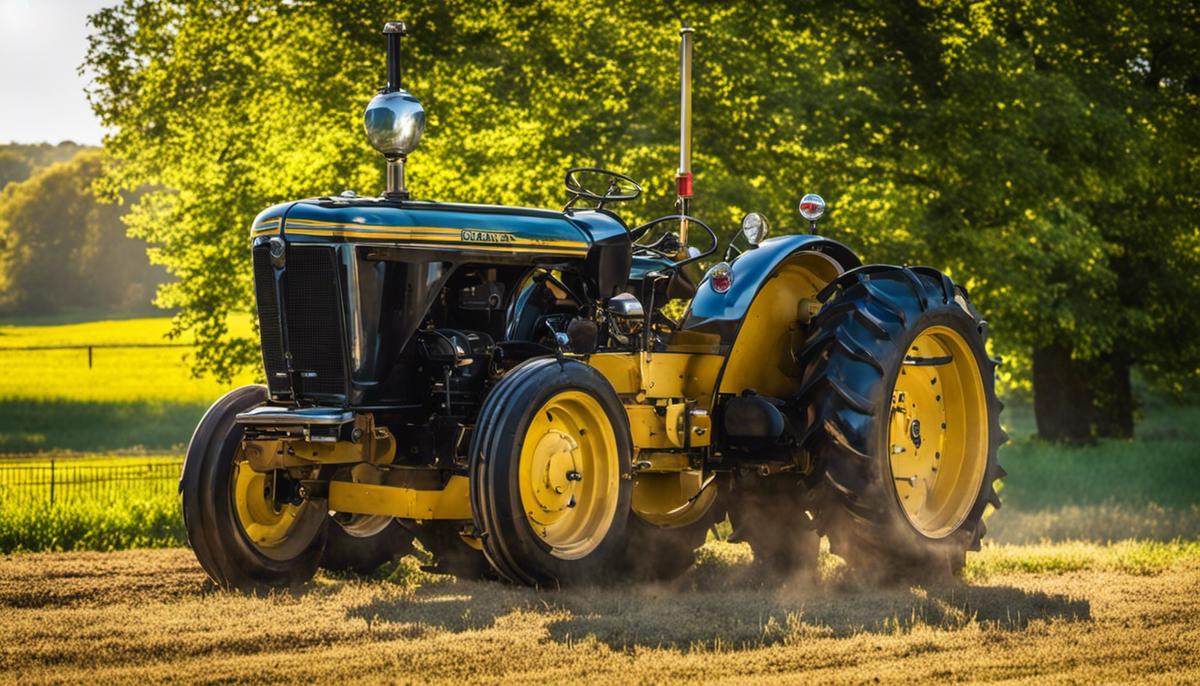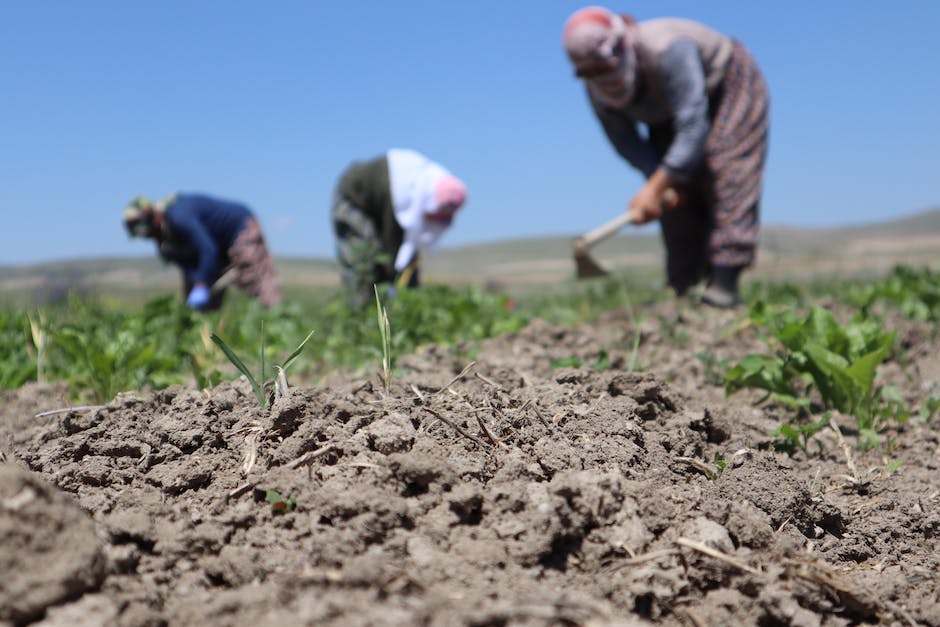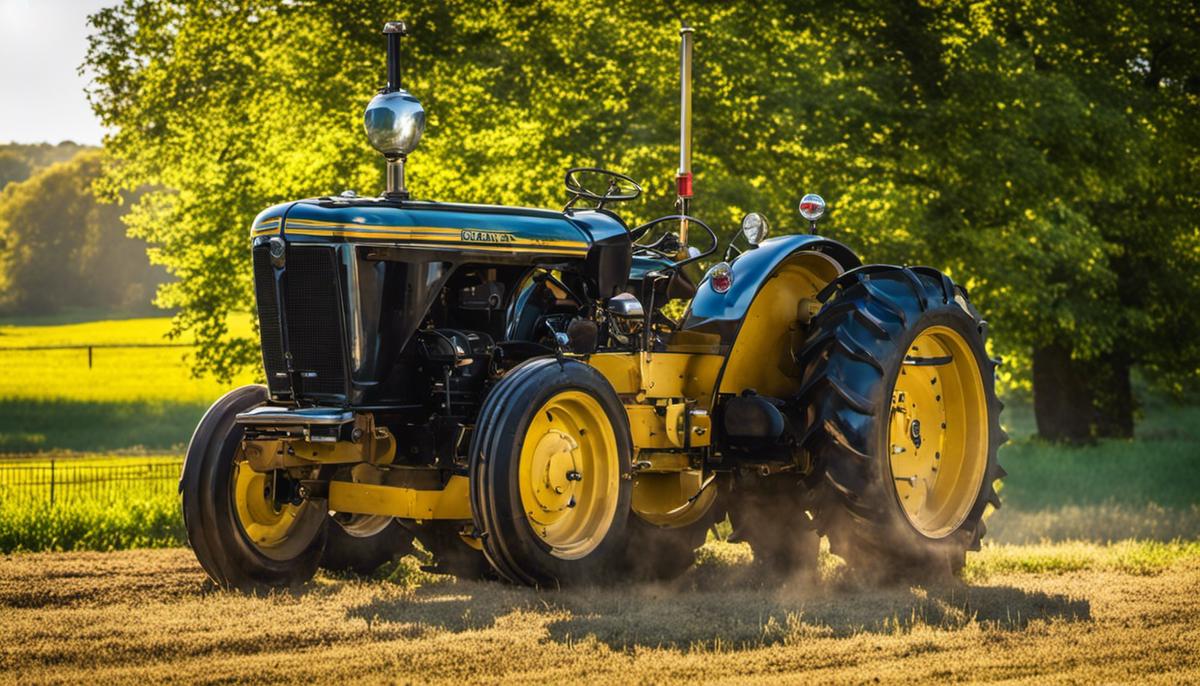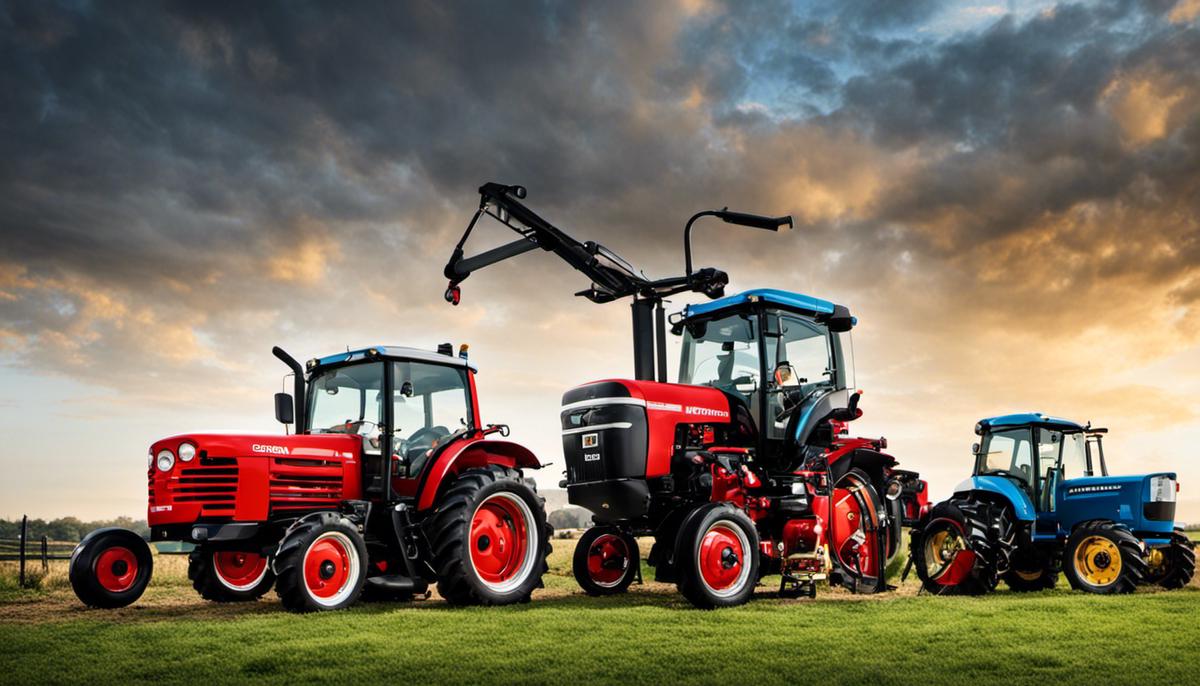

Agridisk
Egypt - Alexandria

All what you need to kow about farm tractors
Description: The wheels of progress in agriculture have been significantly driven by the invention and evolution of farm tractors. Since their early origin as rudimentary horse-drawn devices, farm tractors have reshaped the landscape of agriculture, evolving into an integral powerhouse of modern farming. This journey of progression, dotted with ingenious innovations and transformative leaps, has been shaped by several key historical moments, visionary designers, and pioneering brands like John Deere, Kubota, and Massey Ferguson. As we delve into the world of tractors, we not only explore the technical nuances and maintenance strategies that ensure their peak performance but also investigate their indelible contribution towards fostering sustainable farming practices. Without a doubt, one of the most dramatic and downright exciting transformations in the history of agrarian practices has to be the evolution of the farm tractor. It's a tale brimming with ingenuity and innovation, dotted with tweaks and modifications that have carried farming from the humble horse-drawn plows to the sophisticated, high-tech machinery of today. So, let's dive right in, shall we? Early in the 19th century, plowing was undoubtedly no easy feat. Backbreaking toil and slow, grueling progress was the name of the game, with horses or oxen pulling wooden plows through the furrows. Yet, despite these challenges, this system was the backbone of agriculture, the powerhouse driving rural economies worldwide. The transition towards mechanized farming began to rev up around the mid-1800s. The industrial revolution brought with it the first inklings of change, whisperings of a new era of mechanized farming. The invention of steam powered machines, like Richard Trevithick's steam-driven vehicle in 1802, set the ball rolling. These hulking, metal beasts, though cumbersome and somewhat unreliable, basically kick-started the leap from animal power to mechanical power. As the 20th century rolled in, the steam tractor was replaced by the internal combustion engine tractor. This tractor had numerous advantages over their steam-powered predecessors, including lower cost, lighter weight, and greater efficiency. The introduction of these tractors, like the world-renowned Fordson Model F, brought a revolution, multiplying the productivity of farmers dramatically. The Great Depression and World War II significantly influenced the development of farm tractors too. The need to feed ever-growing populations with less labor forced governments and manufacturers to invest more in agricultural technology. Innovations like pneumatic tires, diesel engines, hydraulically controlled implements, and power take-off accessories came into the picture adding speed, power, and versatility to these machines. By the mid-20th century, tractors began their transformation into the giant, powerful machines we now identify them as. New advancements were incorporated regularly, ramping up their capabilities and efficiencies almost yearly. Extra features such as enclosed cabins, power steering, and advanced braking systems were introduced, enhancing safety and comfort for farmers. Now, in the 21st century, there's just about nothing that tractors can't do. From GPS guided auto-steering to drones monitoring crop health, technology has penetrated into the very heart of the tractor's operation. The modern tractor is an epitome of high-tech agriculture, with sophisticated computer systems offering precision farming, productivity tracking, and detailed weather forecasts. In a nutshell, the evolution from horses to farm tractors has truly revolutionized the world of agriculture, making the impossible possible. And the flame of progress shows no sign of flickering out anytime soon. It's clear as day, the future of farming is as bright and promising as a summer's day harvest. Hold on tight, the ride is far from over! Rolling directly into the topic at hand, what makes the world of farm tractors so utterly fascinating is the variety of types and brands, each one with its unique features and abilities. The spectrum stretches from classic tractors to compact utility ones, from row crop tractors to orchard type machines, and more, each having a strong following and purpose. General purpose tractors have shown great popularity from the beginning due to their versatility in performing a wide range of farming tasks. Their ground-hugging design and moderate horsepower facilities an array of farm work from plowing to hauling. Many a farmer's best friend, brands such as John Deere and Massey Ferguson, lead in this category with their sturdy, reliable models and strong after-sales support. Meanwhile, compact utility tractors, smaller yet nimble variants, have found a special place among owners of smaller plots, landscapers, and hobby farmers. Emphasizing maneuverability and efficient operation, these machines fit into tight spots and offer efficient fuel consumption. Brands like Kubota set the benchmark here with their excellent build and ease of operation. Row crop tractors, on the other hand, are built with taller and more narrow profiles to navigate through rows of crops with minimal disturbance. These tractors provide a higher horsepower range and are often equipped with modern navigational and operational systems. Case IH and New Holland are major players in this category, offering innovative solutions for precision farming. Orchard type tractors are impressive specialists. Designed with a low profile and streamlined design, to prevent damage to low hanging fruits while maneuvering through orchard rows, these machines seamlessly combine power with delicacy. Fendt tractors, known for their advanced German technology, are prominent in this field. The world of specialty tractors, like those used for forestry or municipal work, highlights brands like Valtra. Its tractors are well renowned for their individuality, durability, and ability to work in challenging conditions. While each brand brings a distinct dynamic to the table, it’s the elements of power, reliability, adaptability, service support, and innovative technology that separates the leaders from the rest. The wide landscape of farm tractors is a result of ongoing innovation and the continuous challenge of meeting the ever-evolving needs of the farming community. From humble beginnings to roaring engines and GPS guided systems, the journey of farm tractors is a captivating saga of ingenuity and progress. One can spend a lifetime in this world and always discover something new. It isn't just a machine; It's a testament to human will and capability. On the journey down insights lane, we've explored the captivating evolution of technology that fuels our essential machinery across the field. The focus now turns to the nitty-gritty of operating such complex machines, namely tractors, where a keen understanding of the technical details and maintenance is key to ensuring their longevity and efficiency. First, let's delve into an essential aspect – the engine. The lifeline of any tractor, engines need to be appropriately sized for the intended workload. Too big, and you're wasting fuel; too small, and you risk overheating or mechanical failure. More modern models favor high-torque low-speed engines, which better serve agricultural needs given their better fuel efficiency and lower engine wear. Transmission systems have evolved significantly over time. One must discern between the various types: unsynchronized, synchronized, power shift, and continuously variable transmission (CVT). CVT, in particular, is favored in modern tractors for its ease of use and versatility. It offers unlimited gear options, therefore optimizing the engine’s power and fuel efficiency at different speeds. Hydraulics play a massive role in the functioning of many tractor attachments. The two main systems are open center and closed center. An open-center system pumps hydraulic fluid continuously, while a closed-center system only activates when an implement requires power. Both require careful maintenance to avoid fluid leaks, which can drastically reduce the system's power. Now, let's talk about tires. Tire selection directly affects the tractor's traction, performance, fuel consumption, and ride quality. Depending on the job required, you may prefer anything from conventional pneumatic tires to liquid-filled or radial options. Always maintain proper inflation and routinely check for cuts or bulges that could lead to potential tire failure. Worried about maintenance? Fret not! Keeping your tractor in its prime shape requires just a few key steps. Regular oil and filter changes are essential. Dirty air filters can choke an engine, leading to increased fuel consumption and reduced performance. Similar attention should be paid to fuel filters as blocked ones can damage the injector system and cause engine starting problems. Regular check-ups on the cooling system can avoid engine overheating and radiator damage. Battery life should also not be overlooked; it requires testing for voltage and regular cleaning of terminals to prevent corrosion. And let's not forget about greasing. With so many moving parts, maintaining proper lubrication will significantly reduce wear and tear and extend the life of your machinery. The old adage, “An ounce of prevention is worth a pound of cure,” stands true for tractor maintenance. By staying alert to potential issues, keeping up with regular maintenance, and ensuring the right product for the right job, tractor owners can ensure their powerful machines operate at peak efficiency for many years to come. These hardworking companions of the farming world have come a long way and are geared to take on any task you throw their way. So let's take good care of them, and they will reliably serve us in return. Truly, it's a marvel to imagine how much the humble tractor has revolutionized farming. With that historical context, let's delve deeper into understanding ways tractors have bolstered sustainable farming and explore recent technological advances that promote environmental consciousness. Farm tractors have always been at the heart of efficient, sustainable farming practices. Fuel-efficient engines of varying sizes, designed to perform equally well on both small-scale and industrial farm landscapes, contribute to significant fuel conservation. By optimizing fuel consumption, these engines not only cut down operational cost but also extensively reduce carbon emissions, enhancing the eco-friendliness of farming operations. Moreover, the evolution of transmission systems in tractors offers a powerful case study of human ingenuity in action. Modern tractors often feature continuously variable transmission (CVT), which allows the engine to operate at peak efficiency irrespective of the ground speed. This technological leap facilitates substantial energy savings, again promoting lowered carbon footprints of farming processes and adding another notch to sustainable agriculture. Hydraulics, the lifeblood of tractor attachments, have been instrumental towards improving farming efficiency. Advanced hydraulic systems are capable of powering a host of implements - mowers, loaders, plows, and more. By enabling the versatile use of a single machine, tractors reduce the need for additional specialized equipment, thus streamlining farming procedures while minimizing the industry's carbon footprint. Tire technology also plays an influential role in supporting the green farming initiative. Modern tires provide excellent traction, reducing slippage and hence, fuel wastage. Additionally, the lessened soil compaction allows for better crop growth, creating a symbiotic relationship between technology and nature. Tractor maintenance is another crucial aspect, often overlooked, that can substantially contribute to a sustainable farming lifestyle. Regular oil changes, timely filter replacement, consistent cooling system check-ups, battery upkeep, and greasing moving parts provide the benefits of longevity and efficiency. By preventing untimely breakdowns and ensuring the longevity of these robust machines, farmers protect both their operations and the environment. In other words, a healthy tractor contributes to healthy land! Moreover, ongoing innovation continues to energize this field. Tractors installed with GPS and advanced onboard computers contribute to precision farming practices. Such advancements help in optimized use of resources, accurate planting, efficient pest control, and significant reduction in waste. Even the advent of electric tractors is not far off from becoming an everyday reality, promising zero-emission farming. Similarly, attempts to autonomize farming through self-driving tractors equipped with Artificial Intelligence are taking shape. With smart tractors that can analyze weather patterns, soil conditions, and crop health, the future of sustainable farming is looking brighter than ever. In summary, the tractor, a symbol of mechanical prowess and agricultural resilience, has etched a potent legacy in progressively refining farming practices and conspicuously bolstering sustainability. As technology continues to enhance these stalwart machines, it also illustrates our collective potential to innovate for a greener tomorrow. Indeed, tractors remain an embodiment of mankind's endeavors to balance agricultural productivity with conscious stewardship of our planet.Historical Evolution of Farm Tractors
From Horses to Horsepower: The Evolution of Farm Tractors

Different Types and Brands of Farm Tractors

Technical Know-how and Maintenance Tips for Farm Tractors

The Role of Tractors in Sustainable Farming
